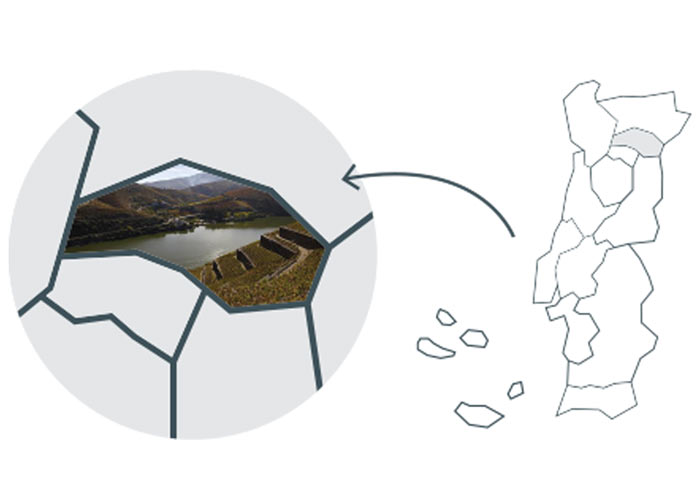Wine regions
Portuguese wine regions
Douro
A bit of history
It is the world’s oldest Protected Designation of Origin – since 1756. Now that is a lot of history. The region’s main star, Port Wine, is known and enjoyed all over the world, and has been spotted at the tables of kings, artists – even James Bond.
It is admired by many, envied by a few, and overly imitated by some, so it is no wonder that some foreign producers are trying to reproduce Port wine elsewhere. The results aren’t brilliant, though. As it so happens, it would take more than using the same grapes, or the same processes, to replicate Douro’s Port Wine. We believe it would take moving the whole Douro river, its mountains, and eventually some of our sun and clouds, to get even close. And that, we’d say, would be pretty inconvenient, even for a large Australian producer.
And rightly so: real Port grows along the Douro, the beautiful river that meets the sea at the city of Porto. Real Port holds ancient labels: Cálem, Kroft, Sandeman, Dow’s, you name it – many of which we can see from our office windows, just across the river.
What to expect?
Some of the world’s finest wines. And it’s not just us saying it: according to Wine Spectator, 3 of the world’s very best wines are Douro, including number 1 – Dow’s 2001 Vintage Port. Interested?
Aside from Port Wine, Douro gives birth to some of Portuguese finest table wines. It is common to find rich, complex blends, many of which based on local varieties Touring Nacional and Touriga Franca.
Besides its great wine, the region is know for heavenly gastronomy and beautiful landscapes – considered World Heritage by UNESCO. So, if you still don’t know it: get moving!
Reds
These wines are produced from native vines such as Touriga Nacional, Touriga Franca, Tinta Roriz (Aragonez), Tinta Barroca and Tinto Cão. The great majority of these wines are the product of a blend of several varietals and they possess an unequalled complexity and richness that is so characteristic of the Douro. There are also good examples of single varietal wines, that is, wines produced from a single variety, especially one of the first three mentioned above.
Wines to be drunk when young: ruby red, with a well balanced body and astringency. The aroma of red fruits such as raspberries and strawberries may be complemented with floral and woody nuances. Young “Douro” wines will be appreciated in all their splendour if drunk during the first few years after they have been made. Among these wines are reds that are more fitting to be drunk with simple meat dishes, salt cod, pasta or pizza. They should be served at between 13º and 15ºC.
Wines to be kept for ageing: deep in colour and possess complex and intense aromas. When young, they show hints of black fruits, chocolate, balsamic herbs, violets and wood. They are well-structured and have persistent tannins. At their peak, which can take some ten years or more, their aromas are subtle and more delicate yet very complex. In the mouth, these wines are soft and velvety and well-balanced. A significant number of the wines for ageing that are produced in the Douro bear the word “Reserve” or “Grand Reserve” on the label.
Common varieties: Touriga Nacional, Touriga Franca, Tinta Roriz (aka. Aragonez), Tinta Barroca and Tinto Cão
White Wines
There are great Douro white wines just waiting to be discovered. Dry whites are produced by blending several varietals such as Malvasia Fina,Viosinho, Gouveio and Rabigato.
Wines to be drunk when young: Pale in colour, with refreshing fruity (citrus and other tree- borne fruits) and floral aromas, these wines are well-balanced in the mouth and show their youth. They are a good accompaniment to fish dishes and salads and may also be appreciated as an aperitif. These wines should be drunk chilled, between 8º and 10ºC.
Wines to be kept for ageing: The aromas of these wines are intense and the wines are complex and usually ferment or age in wood. In the latter case, they are golden in colour with toasty aromas and nuances of tropical fruits. They are full and long-lasting in the mouth. We recommend that you drink them with fatty fish dishes such as salmon or salt cod, but they are equally good with chicken or rabbit dishes that are accompanied by mild sauces. The majority bear the word “Reserve” or “Grand Reserve” designation on the label and should be served less chilled, at around 12ºC. These wines may be kept several years before drinking.
Common varieties: Malvasia Fina, Viosinho, Gouveio and Rabigato.
Rosé Wines
Accompanying the worldwide consumer trend, the Douro has seen the birth of an increasing number of rosé wines. These wines are only made by lightly macerated red grapes. They have a lovely pink colour and possess exuberant young aromas of raspberry, cherry and hard sweets. In the mouth, one is easily captivated by their smoothness, sweetness and acidity.
These wines are ideal as an aperitif in the summer and they are perfect companions for oriental food such as dishes from Japan (sushi), India or Southeast Asia (Thai and Vietnamese food).
They should be drunk young (1 to 2 years old) and lightly chilled, between 10º and 12ºC.
Adapted from: Instituto do Vinho do Douro e Porto, Instituto do Vinho e da Vinha, Wines of Portugal.


